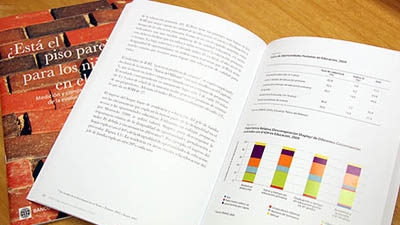“This objective implies allocating limited public resources in an equitable, efficient and effective manner,” she added. Compared with 18 other Latin American and Caribbean countries included in the HOI, Peru ranks sixth in terms of completing primary school on time, 14th in access to safe water, 10th in access to sanitation and 15th in access to electricity.
“What is most worrying is that this access is closely associated with circumstances such as where the child lives and the socioeconomic level of his or her parents. In a country that aspires to give all citizens the same opportunities for a full and productive life, these circumstances should not be a determinant factor for access to these basic opportunities,” said Saavedra.
The HOI of Peru for completing primary school on time is 50 (the index ranges from 0 to 100). Insufficient coverage and an unequal distribution of opportunities explain this low rating. Peru has been more successful in expanding coverage of pre-school education. With respect to infrastructure, the study concluded that HOI performance was uneven. The HOI for cellphone coverage grew significantly, from 8 to 52 between 2004 and 2009, although marked disparities persist.
In terms of the HOI, access to electricity rose from 52 to 67 with sanitation increasing from 44 to 55, due, in both cases, to improved coverage and more equitable distribution. In contrast, improvements in drinking water were limited and the HOI for Peruvian children free from chronic malnutrition is only 53.
Overall, education, parents’ income and birthplace still play a major role in the inequality in opportunities faced by Peruvian children. A comparison of sub-national areas in Latin America found that the rural highlands and jungle offer the fewest opportunities for children in terms of electricity and safe water, and to a lesser extent, sanitation.
Future generations will face even greater challenges if efforts are not stepped up to greatly reduce this inequality in access to opportunities to build a better future. To this end, systems to monitor the effectiveness of public policy should not only prioritize the level of advances in key indicators, but also existing gaps between children from different socioeconomic backgrounds as well as those from rural and urban areas. While these gaps are indeed narrowing, it is at a very slow pace.For the first time in the country, a ministry solely responsible for social policy has been created. Their mandate; to achieve development and social inclusion through policies designed by the people, for the people. This will begin with those whose circumstances impede their access to quality public services and hinder their ability to take advantage of opportunities generated by economic growth.
Effectively identifing targets and monitoring and evaluation tools will be key to succesfully achieving this mandate and measure whether advances are being made. "If we do not know where we are and we do not clearly establish where we are going, any road will take us there, and that is not what the children of this country need," said MIDIS Vice-Minister, Juan Pablo Silva.
He added that the task of improving results should not be limited to improving national averages, but rather should focus on reducing the existing gaps between households facing circumstances associated with exclusion and the rest of the country. This is why the MIDIS chose to present its Conocer para incluir plan in Puno, the region with the largest number of households currently undertaking this process of inclusion in the country.
The plan brings together all the necessary targeting, monitoring and evaluation tools to achieve sectoral and inter-governmental cooperation in order to reach these social goals. "These reforms should not be launched in Lima, but rather where the problems are," said Silva.
Through the MIDIS and other government programs, regional and local governments are attempting to effectively implement a development and inclusion policy based on the needs of the population. These take advantage of the opportunities for innovation and continuous learning afforded by a monitoring and evaluation system focused on reducing the social gap.
----------------------
This study uses the Human Opportunity Index, which is a measurement tool introduced in 2009 in a World Bank Study for Latin America and the Caribbean. The HOI measures inequality of opportunities in access to a specific group of goods and services – which are referred to as "basic opportunities" -- and their relation with a set of "circumstances" for a particular population segment: children and young people under age 18. This study includes variables such as gender, location (urban/rural), altitude of district of residence, education and income of the head of the household, family structure (number of siblings and whether there are two parents present) and ethnic group (estimated based on the mother tongue spoken at home).

